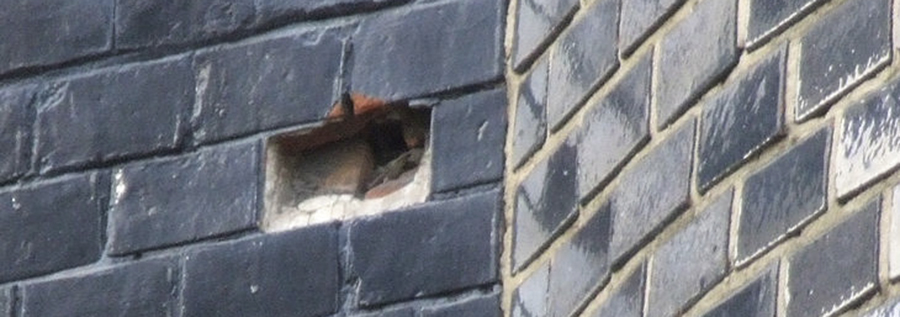Mathematical tile
The mathematical tile was an external cladding or tile hanging solution that was popular in the 17-1800's in the South of England. The tiles were shaped in such a way that they interlocked and from the outside face resembled a brick facade and were a popular cladding solution for timber frame buildings.
It has been suggested that the tiles were designed as an alternative to bricks as a result of the brick tax introduced by King George III in 1784, however although known as the Brick tax, it actually also covered tiles and so these were subject to the same tax, though unclear if less. It is more likely that the tiles represented a useful solution to dealing with the facade of timber frame buildings in seasde locations, because they were cheaper, simpler and quicker to construct than brick and in many respects as, if not more resistant to weathering.
In areas around the South Coast of England, such as Brighton and Lewes a specific black glazed version of the tile was popular, many examples of which can still be seen today. (image credit Stuart Walsh under CC license)
[edit] Related articles on Designing Buildings
- Battens.
- Ceiling tiles.
- Ceramic tiles.
- Domestic roofs.
- Flashing.
- Flat roof defects.
- Metal profile cladding.
- Metal roofing.
- Nails - a brief history.
- Photocatalytic tiles.
- Pitched roof.
- Roof coverings.
- Roof insulation.
- Roof slates.
- Roofing defects.
- Shingle roofing.
- Thatch roofing.
- Tiles.
- Tile roofing.
- Types of nails.
- Types of roof.
- Weatherboarding.
Featured articles and news
International Electrician Day, 10 June 2025
Celebrating the role of electrical engineers from André-Marie Amperè, today and for the future.
New guide for clients launched at Houses of Parliament
'There has never been a more important time for clients to step up and ...ask the right questions'
The impact of recycled slate tiles
Innovation across the decades.
EPC changes for existing buildings
Changes and their context as the new RdSAP methodology comes into use from 15 June.
Skills England publishes Sector skills needs assessments
Priority areas relating to the built environment highlighted and described in brief.
BSRIA HVAC Market Watch - May 2025 Edition
Heat Pump Market Outlook: Policy, Performance & Refrigerant Trends for 2025–2028.
Committing to EDI in construction with CIOB
Built Environment professional bodies deepen commitment to EDI with two new signatories: CIAT and CICES.
Government Grenfell progress report at a glance
Line by line recomendation overview, with links to more details.
An engaging and lively review of his professional life.
Sustainable heating for listed buildings
A problem that needs to be approached intelligently.
50th Golden anniversary ECA Edmundson apprentice award
Deadline for entries has been extended to Friday 27 June, so don't miss out!
CIAT at the London Festival of Architecture
Designing for Everyone: Breaking Barriers in Inclusive Architecture.
Mixed reactions to apprenticeship and skills reform 2025
A 'welcome shift' for some and a 'backwards step' for others.
Licensing construction in the UK
As the latest report and proposal to licence builders reaches Parliament.
Building Safety Alliance golden thread guidance
Extensive excel checklist of information with guidance document freely accessible.
Fair Payment Code and other payment initiatives
For fair and late payments, need to work together to add value.
Pre-planning delivery programmes and delay penalties
Proposed for housebuilders in government reform: Speeding Up Build Out.
High street health: converting a building for healthcare uses
The benefits of health centres acting as new anchor sites in the high street.

























